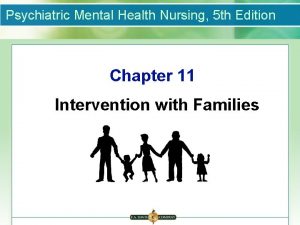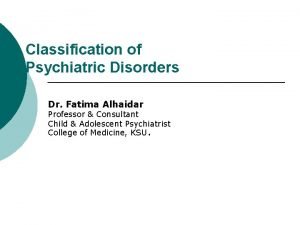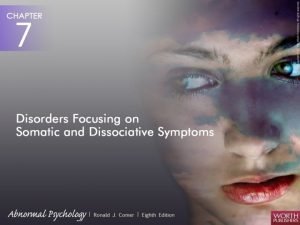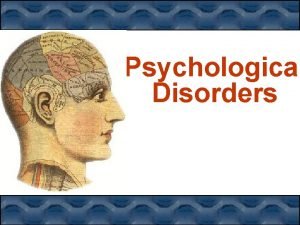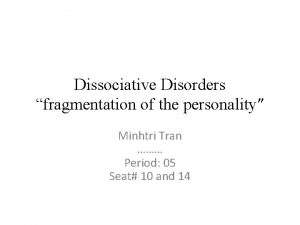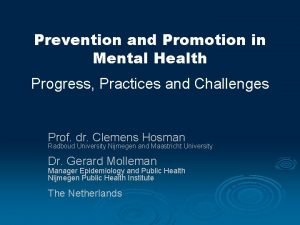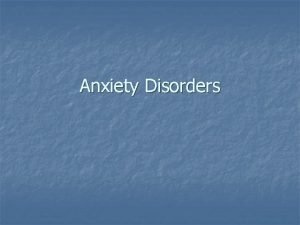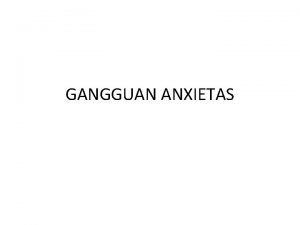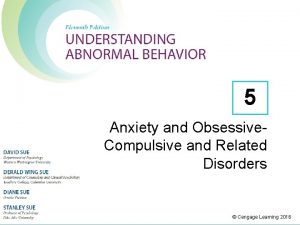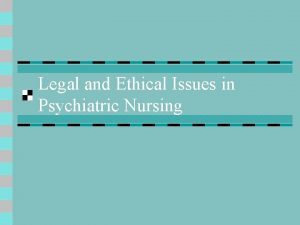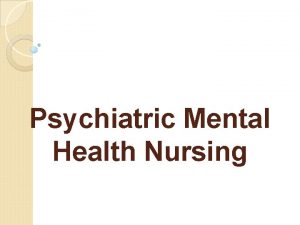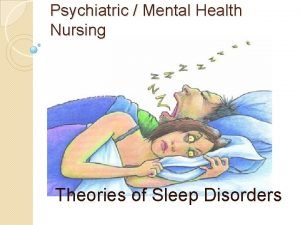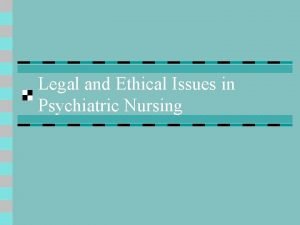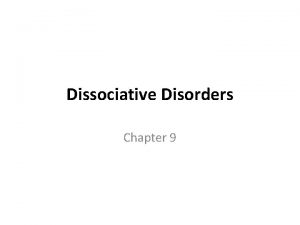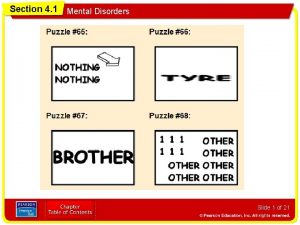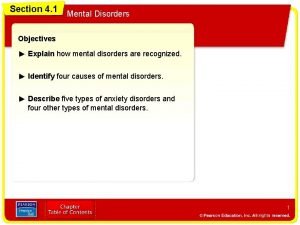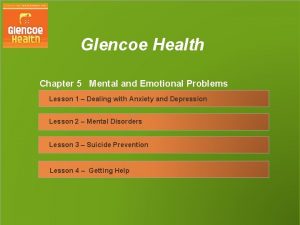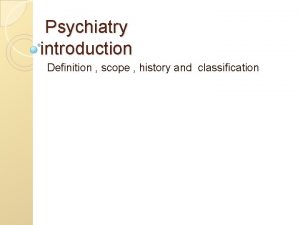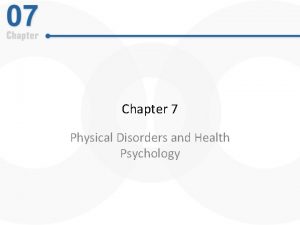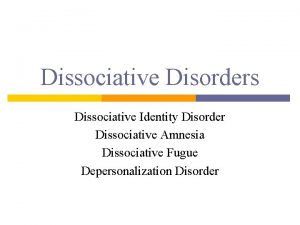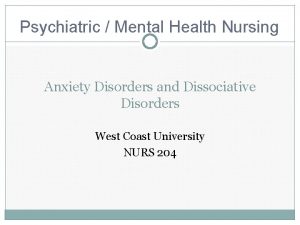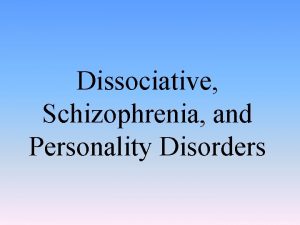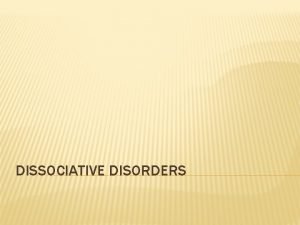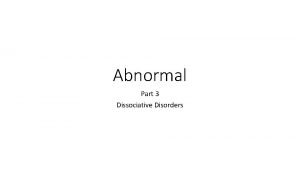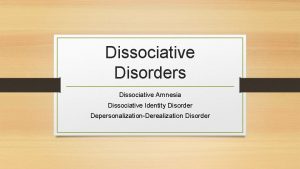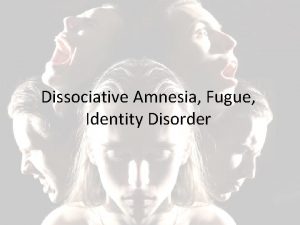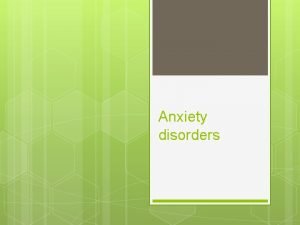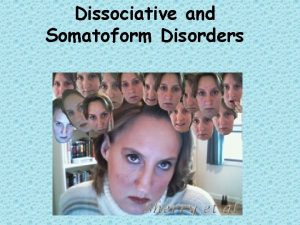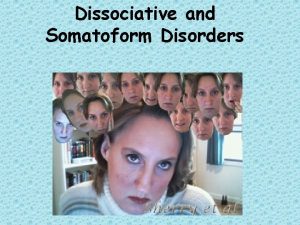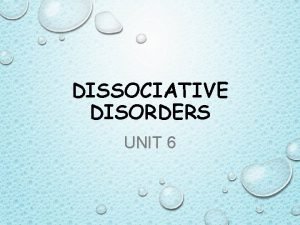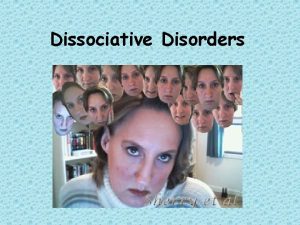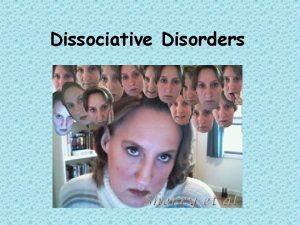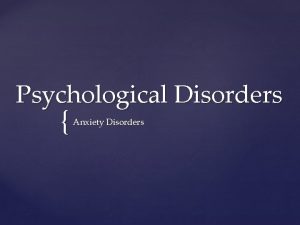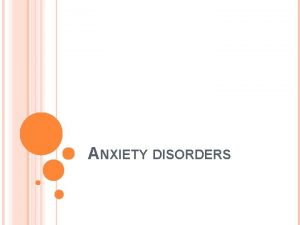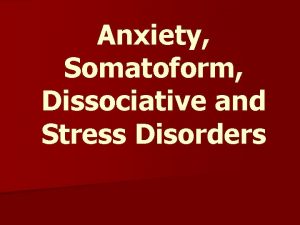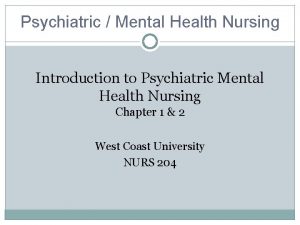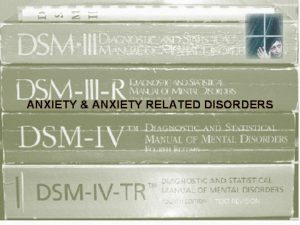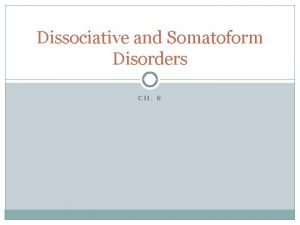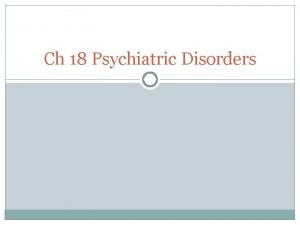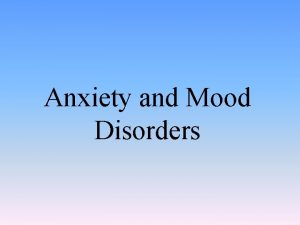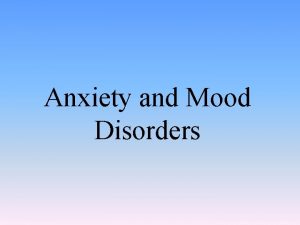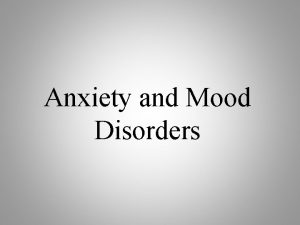Psychiatric Mental Health Nursing Anxiety Disorders and Dissociative































- Slides: 31

Psychiatric / Mental Health Nursing Anxiety Disorders and Dissociative Disorders West Coast University NURS 204

Learning Objectives Identify theories in understanding anxiety disorders and dissociative disorders Explain the concept of anxiety and how it relates to anxiety disorders and dissociative disorders Compare and contrast both the common themes and distinctive characteristics of anxiety disorders with dissociative disorders. Incorporate how dissociation serves as a defense mechanism for some individuals experiencing trauma into the care of clients with dissociative disorders Conduct a comprehensive assessment in the care of clients with anxiety and dissociative disorders.

Learning Objectives Design a plan of care for intervening into mild, moderate, severe, and panic levels of anxiety. Educate clients and their families about pharmacologic and non-pharmacologic measures for anxiety disorders and dissociative disorders Identify the possible personal challenges in caring for clients with anxiety disorders and dissociative disorders.

Theories: Anxiety Disorders Biological changes in the brain Noradrenergic system is sensitive to norepinephrine; locus ceruleus is involved in precipitating panic attacks. Dopamine system involved in pathophysiology of OCD. GABA dysfunction affects development of panic disorder.

Theories: Anxiety Disorders - continued Abnormal control of glutamate plays role in anxiety disorders. Hormonal changes in pregnant women affect certain anxiety disorders. Lactic acid may precipitate anxiety. Caffeine and nicotine may trigger panic attacks. Genetic theories: strong evidence for familial or genetic predisposition for anxiety disorders Psychosocial theories: in psychoanalytic theory, anxiety is viewed as sign of psychologic conflict; anxiety is the outcome of repressing forbidden impulses

Theories: Anxiety Disorders - continued Behavioral theory Anxiety is a learned response that can be unlearned. Compulsive behavior is a maladaptive attempt to alleviate anxiety. Behavior modification teaches new ways to behave Humanistic theories: Environmental stressors, biological factors, and intrapsychic fears cannot be dealt with separately but rather as they interact with one another. Treatment approaches are integrative.

Anxiety A universal experience A normal response that usually helps cope with threatening situations Anxiety disorders are characterized by anxiety so disabling as to adversely affect day-to-day functioning Affects all age groups

Anxiety - continued Anxiety disorders are most common of mental illnesses All anxiety disorders have in common excessive, irrational fear and dread Anxiety is either a dominant disturbance or an avoidance behavior Free-floating anxiety is unrelated to a specific stimulus

Anxiety - continued Panic disorder Phobia Generalized Anxiety Disorder (GAD)


YOUR ASSESSMENT APPROACH: The Client with Anxiety Disorder

YOUR ASSESSMENT APPROACH: The Client with Panic Attack

Plan of Care for Anxiety Mild to moderate anxiety Use a calm, quiet approach Observe client’s verbal/nonverbal behavior Encourage client to verbalize feelings Teach relaxation techniques (meditation, guided imagery, etc. ) when anxiety is mild Simple physical activities often help reduce anxiety Develop goal-oriented contract

Plan of Care for Anxiety - continued Severe to panic levels of anxiety: First priority is to reduce anxiety to tolerable levels. Stay with the client. Provide a safe and supportive milieu. Use a firm voice and short, simple sentences. Place client in quieter, smaller, less stimulating environment; focus the client’s diffuse energy on repetitive task or tiring task. Administer antianxiety medication if ordered.

Theories: Dissociative Disorders Biological factors Serotonin Limbic system Physical illnesses and certain drugs Various personality states in dissociative identity disorder have different activity in frontal and temporal lobes. Genetic theories: Dissociative disorder occurs more often in first-degree biologic relatives

Theories: Dissociative Disorders - continued Psychosocial theories: Current explanations are based on Freud’s dynamic concepts. Repression of ideas leads to amnesia, to protect oneself from emotional pain. Dissociative identity disorder is a result of childhood chronic trauma. Behavioral theories: Dissociative disorders are learned behaviors that provide protection from a painful experience. Humanistic theories: The person is a composite of life experiences, psychobiological factors, and interpersonal interactions.

Distinctive Characteristics of Dissociative Disorder Consciousness, memory, identity, and perception of environment are impaired. Disorders include dissociative amnesia, dissociative fugue, dissociative identity disorder, and depersonalization disorder. Dissociation is a defense against trauma that separates emotions from behaviors. Dissociation is a response to extreme childhood trauma. Dissociation Emotional numbing Impaired social relationships Separates emotions from behaviors

Care of Clients with Dissociative Disorders Most clients with dissociative disorder seen in community rather than inpatient settings Obtain subjective and objective data Complete psychosocial and physical assessment Decide whether priority is to alleviate symptoms or reintegrate anxiety-producing conflict. Behavioral modification helps alleviate some problematic behaviors. Provide safe, supportive environment. Teach desensitization to conflict. Medication plays a key role in treatment.

YOUR ASSESSMENT APPROACH: The Client with Dissociative Identity Disorder

YOUR ASSESSMENT APPROACH: The Client with Depersonalization Disorder

Common Themes Anxiety disorders and dissociative identity disorder originate in childhood. Major common theme = disabling anxiety Other common features: personality and mood changes, distorted perceptions, inability to concentrate, memory impairment, defense mechanisms Both anxiety and dissociative disorders may have underlying comorbid illnesses like depression or substance abuse. Both disorders profoundly affect quality of life. Psychotropic medications and teaching adaptive coping are mainstays of treatment. A holistic approach is best for caring for these clients.

Comprehensive Assessment Conduct a history and physical exam. Gather subjective and objective information. Interview family member(s) if possible. Complete psychosocial assessment to discover source of anxiety. Differentiate between anxiety and depression. Evaluate sleep and sleep quality. Complete suicide and homicide assessment. Major focuses for a client with dissociative disorder are identity, memory, and consciousness.

Client/Family Education Medications used to treat anxiety disorders include benzodiazepines, tricyclics, SSRIs and SNRIs, lithium, beta blockers, alpha-adrenergic antagonists, atypical antipsychotics, and neuroleptics. Teach about medication indications, side effects, and drug–drug interactions.

Client/Family Education - continued Teaching about medications Drowsiness is a common side effect. Do not drink alcohol while taking. Drink decaffeinated beverages. Do not take other medications or adjust dosage in any way without consulting health care provider.

Client/Family Education - continued Nonpharmacologic measures comprise effective coping skills: CBT techniques (desensitization, reciprocal inhibition, cognitive restructuring) Relaxation training Individual or group therapy Exercise and nutrition

Personal Challenges Anxiety is contagious. The nurse may be impatient and irritated by somatic complaints. It is important to identify the source of one’s own anxiety and consistently role-model adaptive behavior. A client’s avoidance mechanism can be challenging to staff. Some nurses feel overwhelmed and helpless in the face of clients’ pain and catharsis. Ready answers are more likely to interfere with client’s communication.

Psychopharmacology - Anxiolytics Anti-anxiety medication relieve insomnia, anti- convulsant, muscle relaxant, alcohol withdrawal Side effect: Sedation, mental confusion, amnesia, ataxia May cause withdrawal symptoms: anxiety, insomnia, seizure, muscle tension Important to taper dose by no more that 25% per week to prevent withdrawal symptoms

Psychopharmacology - Anxiolytics Benzodiazepines Alprazolan - Xanax (0. 25 - 4 mg/d) Chlordiazepoxide - Librium (50 - 300 mg/d) Clonazepam - Klonopin (0. 25 - 4 mg/d) Clorazepate - Tranxene (15 - 10 mg/d Diazepam - Valium (15 - 40 mg/d) Lorazepam - Ativan (1 - 10 mg/d) Oxazepam - Serax (30 - 120 mg/d)

Psychopharmacology - Anxiolytics Other Anxiolytics and Sleep Medication Buspiron - Buspar (10 - 60 mg/d) Zolpidem - Ambien (5 - 10 mg/d) Zaleplon - Sonata (10 mg/d) Eszopiclone -Lunesta (1 -3 mg/d) Rameltoeon - Rozerem (8 mg/d) Cholral Hydrate - Noctec (500 - 2000 mg/d) Diphenhydramine - Benadryl, Sominex, Nytol (25 - 100 mg/d)

Resources http: //www. adaa. org The Anxiety Disorders Association of America (ADAA) is a national nonprofit organization dedicated to the prevention, treatment, and cure of anxiety disorders and to improving the lives of all people who suffer from them. http: //www. isst-d. org The International Society for the Study of Trauma and Dissociation is a professional association organized to develop and promote comprehensive, clinically effective, and empirically based resources and responses to trauma and dissociation. http: //www. ncptsd. va. gov/ncmain/information The National Center for Posttraumatic Stress Disorder Information Center provides information to interested individuals, including veterans and their family members.

Resources http: //www. socialphobia. org The Social Phobia/Social Anxiety Association site offers further links to topics such as current news, treatment, and local group availability. Kneisl, C. R. , Trigoboff, E. (2009). Contemporary psychiatric-mental health nursing. Anxiety and Dissociative Disorder (2 nd ed. ) (pp. 443 -477). Upper Saddle River, NJ: Pearson Education.
 Chapter 11 psychiatric mental health nursin
Chapter 11 psychiatric mental health nursin Pes in nursing process
Pes in nursing process Nursing process in psychiatric nursing
Nursing process in psychiatric nursing Chapter 29 somatic symptom and dissociative disorders
Chapter 29 somatic symptom and dissociative disorders Neurosis vs psychosis
Neurosis vs psychosis Dissociative disorders
Dissociative disorders Types of dissociative disorders
Types of dissociative disorders Derealization quotes
Derealization quotes Chapter 21 mental health diseases and disorders
Chapter 21 mental health diseases and disorders Chapter 15 anxiety and obsessive-compulsive disorders
Chapter 15 anxiety and obsessive-compulsive disorders Mental health disorders
Mental health disorders Anxiety disorders def
Anxiety disorders def Icd x anxiety disorders
Icd x anxiety disorders Multipath model of anxiety disorders
Multipath model of anxiety disorders Ethical and legal issues in psychiatric nursing
Ethical and legal issues in psychiatric nursing Chapter 20 mental health and mental illness
Chapter 20 mental health and mental illness Mental health nursing definition according to who
Mental health nursing definition according to who History of psychiatric nursing
History of psychiatric nursing Psychiatric nursing theories
Psychiatric nursing theories Ethical issues in psychiatric nursing
Ethical issues in psychiatric nursing Dissociative fugue
Dissociative fugue Mental illness mental health jeopardy
Mental illness mental health jeopardy Conclusion of community mental health nursing
Conclusion of community mental health nursing Anxiety goals for nursing care plan
Anxiety goals for nursing care plan Dr fayad
Dr fayad Section 4-1 mental disorders answers
Section 4-1 mental disorders answers Section 4-1 mental disorders answers
Section 4-1 mental disorders answers Glencoe health chapter 9
Glencoe health chapter 9 Chapter 5 mental and emotional problems answer key
Chapter 5 mental and emotional problems answer key Derealiation
Derealiation Unit 14 health and social care
Unit 14 health and social care Physical disorders and health psychology
Physical disorders and health psychology
